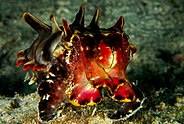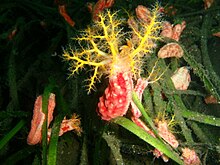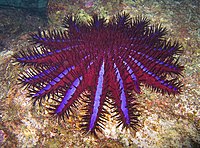Aposematism
Aposematism is the
The term was coined in 1877 by Edward Bagnall Poulton[3][4] for Alfred Russel Wallace's concept of warning coloration.[5] Aposematism is exploited in Müllerian mimicry, where species with strong defences evolve to resemble one another. By mimicking similarly coloured species, the warning signal to predators is shared, causing them to learn more quickly at less of a cost.
A genuine aposematic signal that a species actually possesses chemical or physical defences is not the only way to deter predators. In Batesian mimicry, a mimicking species resembles an aposematic model closely enough to share the protection, while many species have bluffing deimatic displays which may startle a predator long enough to enable an otherwise undefended prey to escape.
Etymology
The term aposematism was coined by the English zoologist Edward Bagnall Poulton in his 1890 book The Colours of Animals. He based the term on the Ancient Greek words ἀπό apo 'away' and σῆμα sēma 'sign', referring to signs that warn other animals away.[3][4]
Defense mechanism

The function of aposematism is to prevent attack, by warning potential predators that the prey animal has defenses such as being unpalatable or poisonous. The easily detected warning is a primary defense mechanism, and the non-visible defenses are secondary.
The most common and effective colors are red, yellow, black, and white.[10] These colors provide strong contrast with green foliage, resist changes in shadow and lighting, are highly chromatic, and provide distance dependent camouflage.[10] Some forms of warning coloration provide this distance dependent camouflage by having an effective pattern and color combination that do not allow for easy detection by a predator from a distance, but are warning-like from a close proximity, allowing for an advantageous balance between camouflage and aposematism.[11] Warning coloration evolves in response to background, light conditions, and predator vision.[12] Visible signals may be accompanied by odors, sounds or behavior to provide a multi-modal signal which is more effectively detected by predators.[13]

Unpalatability, broadly understood, can be created in a variety of ways. Some
Prevalence
In terrestrial ecosystems
Aposematism is widespread in insects, but less so in
Perhaps the most numerous aposematic vertebrates are the poison dart frogs (family: Dendrobatidae).[19] These neotropical anuran amphibians exhibit a wide spectrum of coloration and toxicity.[20] Some species in this poison frog family (particularly Dendrobates, Epipedobates, and Phyllobates) are conspicuously coloured and sequester one of the most toxic alkaloids among all living species.[21][22] Within the same family, there are also cryptic frogs (such as Colostethus and Mannophryne) that lack these toxic alkaloids.[23][24] Although these frogs display an extensive array of coloration and toxicity, there is very little genetic difference between the species.[20] Evolution of their conspicuous coloration is correlated to traits such as chemical defense, dietary specialization, acoustic diversification, and increased body mass.[25][22]
Some plants are thought to employ aposematism to warn herbivores of unpalatable chemicals or physical defences such as prickled leaves or thorns.[26] Many insects, such as cinnabar moth caterpillars, acquire toxic chemicals from their host plants.[27] Among mammals, skunks and zorillas advertise their foul-smelling chemical defences with sharply contrasting black-and-white patterns on their fur, while the similarly-patterned badger and honey badger advertise their sharp claws, powerful jaws, and aggressive natures.[28] Some brightly coloured birds such as passerines with contrasting patterns may also be aposematic, at least in females; but since male birds are often brightly coloured through sexual selection, and their coloration is not correlated with edibility, it is unclear whether aposematism is significant.[29]
The sound-producing rattle of rattlesnakes is an acoustic form of aposematism.[30] Sound production by the caterpillar of the Polyphemus moth, Antheraea polyphemus, may similarly be acoustic aposematism, connected to and preceded by chemical defences.[31] Similar acoustic defences exist in a range of Bombycoidea caterpillars.[32]
In marine ecosystems
The existence of aposematism in marine ecosystems has been debated.[35] Many marine organisms, particularly those on coral reefs, are brightly coloured or patterned, including sponges, corals, molluscs, and fish, with little or no connection to chemical or physical defenses. Caribbean reef sponges are brightly coloured, and many species are full of toxic chemicals, but there is no statistical relationship between the two factors.[36]
Nudibranch molluscs are the most commonly cited examples of aposematism in marine ecosystems, but the evidence for this has been contested,[37] mostly because (1) there are few examples of mimicry among species, (2) many species are nocturnal or cryptic, and (3) bright colours at the red end of the colour spectrum are rapidly attenuated as a function of water depth. For example, the Spanish Dancer nudibranch (genus Hexabranchus), among the largest of tropical marine slugs, potently chemically defended, and brilliantly red and white, is nocturnal and has no known mimics.[38]
Mimicry is to be expected as

The

It has been proposed that aposematism and mimicry is less evident in marine invertebrates than terrestrial insects because predation is a more intense selective force for many insects, which disperse as adults rather than as larvae and have much shorter generation times.
Blue-ringed octopuses are venomous. They spend much of their time hiding in crevices whilst displaying effective camouflage patterns with their dermal chromatophore cells. However, if they are provoked, they quickly change colour, becoming bright yellow with each of the 50-60 rings flashing bright iridescent blue within a third of a second.[44] It is often stated this is an aposematic warning display,[45][46][47][48] but the hypothesis has rarely if ever been tested.[49]
Behaviour
The mechanism of defence relies on the memory of the would-be predator; a bird that has once experienced a foul-tasting grasshopper will endeavor to avoid a repetition of the experience. As a consequence, aposematic species are often gregarious. Before the memory of a bad experience attenuates, the predator may have the experience reinforced through repetition. Aposematic organisms are often slow-moving, as they have little need for speed and agility. Instead, their morphology is frequently tough and resistant to injury, thereby allowing them to escape once the predator is warned off.[50]
Aposematic species do not need to hide or stay still as cryptic organisms do, so aposematic individuals benefit from more freedom in exposed areas and can spend more time foraging, allowing them to find more and better quality food.[51] They may make use of conspicuous mating displays, including vocal signals, which may then develop through sexual selection.[52][22]
Origins of the theory
Wallace, 1867
In a letter to Alfred Russel Wallace dated 23 February 1867, Charles Darwin wrote, "On Monday evening I called on Bates & put a difficulty before him, which he could not answer, & as on some former similar occasion, his first suggestion was, 'you had better ask Wallace'. My difficulty is, why are caterpillars sometimes so beautifully & artistically coloured?"[53] Darwin was puzzled because his theory of sexual selection (where females choose their mates based on how attractive they are) could not apply to caterpillars since they are immature and hence not sexually active.
Wallace replied the next day with the suggestion that since some caterpillars "...are protected by a disagreeable taste or odour, it would be a positive advantage to them never to be mistaken for any of the palatable catterpillars [sic], because a slight wound such as would be caused by a peck of a bird's bill almost always I believe kills a growing catterpillar. Any gaudy & conspicuous colour therefore, that would plainly distinguish them from the brown & green eatable catterpillars, would enable birds to recognise them easily as at a kind not fit for food, & thus they would escape seizure which is as bad as being eaten."[54]
Since Darwin was enthusiastic about the idea, Wallace asked the
Poulton, 1890

Wallace coined the term "warning colours" in an article about animal coloration in 1877.[5] In 1890 Edward Bagnall Poulton renamed the concept aposematism in his book The Colours of Animals.[4] He described the derivation of the term as follows:
The second head (Sematic Colours) includes Warning Colours and Recognition Markings: the former warn an enemy off, and are therefore called Aposematic [Greek, apo, from, and sema, sign][58]
Evolution
Aposematism is paradoxical in evolutionary terms, as it makes individuals conspicuous to predators, so they may be killed and the trait eliminated before predators learn to avoid it.[59] If warning coloration puts the first few individuals at such a strong disadvantage, it would never last in the species long enough to become beneficial.[60]
Supported explanations
There is evidence for explanations involving dietary conservatism, in which predators avoid new prey because it is an unknown quantity;[61] this is a long-lasting effect.[61][62][63] Dietary conservatism has been demonstrated experimentally in some species of birds and fish.[64][61][63][65]
Further, birds recall and avoid objects that are both conspicuous and foul-tasting longer than objects that are equally foul-tasting but cryptically coloured.[66] This suggests that Wallace's original view, that warning coloration helped to teach predators to avoid prey thus coloured, was correct.[67] However, some birds (inexperienced starlings and domestic chicks) also innately avoid conspicuously coloured objects, as demonstrated using mealworms painted yellow and black to resemble wasps, with dull green controls. This implies that warning coloration works at least in part by stimulating the evolution of predators to encode the meaning of the warning signal, rather than by requiring each new generation to learn the signal's meaning.[67] All of these results contradict the idea that novel, brightly coloured individuals would be more likely to be eaten or attacked by predators.[61][68]
Alternative hypotheses
Other explanations are possible. Predators might innately fear unfamiliar forms (neophobia)[69] long enough for them to become established, but this is likely to be only temporary.[60][69][70]
Alternatively, prey animals might be sufficiently
Another possibility is that a gene for aposematism might be
A further explanation is that females might prefer brighter males, so sexual selection could result in aposematic males having higher reproductive success than non-aposematic males if they can survive long enough to mate. Sexual selection is strong enough to allow seemingly maladaptive traits to persist despite other factors working against the trait.[19]
Once aposematic individuals reach a certain threshold population, for whatever reason, the predator learning process would be spread out over a larger number of individuals and therefore is less likely to wipe out the trait for warning coloration completely.[76] If the population of aposematic individuals all originated from the same few individuals, the predator learning process would result in a stronger warning signal for surviving kin, resulting in higher inclusive fitness for the dead or injured individuals through kin selection.[77]
A theory for the evolution of aposematism posits that it arises by reciprocal selection between predators and prey, where distinctive features in prey, which could be visual or chemical, are selected by non-discriminating predators, and where, concurrently, avoidance of distinctive prey is selected by predators. Concurrent reciprocal selection (CRS) may entail learning by predators or it may give rise to unlearned avoidances by them. Aposematism arising by CRS operates without special conditions of the gregariousness or the relatedness of prey, and it is not contingent upon predator sampling of prey to learn that aposematic cues are associated with unpalatability or other unprofitable features.[78]
Mimicry
Aposematism is a sufficiently successful strategy to have had significant effects on the evolution of both aposematic and non-aposematic species.
Non-aposematic species have often evolved to mimic the conspicuous markings of their aposematic counterparts. For example, the hornet moth is a deceptive mimic of the yellowjacket wasp; it resembles the wasp, but has no sting. A predator which avoids the wasp will to some degree also avoid the moth. This is known as Batesian mimicry, after Henry Walter Bates, a British naturalist who studied Amazonian butterflies in the second half of the 19th century.[79] Batesian mimicry is frequency dependent: it is most effective when the ratio of mimic to model is low; otherwise, predators will encounter the mimic too often.[80][81]
A second form of mimicry occurs when two aposematic organisms share the same
Many species of bee and wasp that occur together are Müllerian mimics. Their similar coloration teaches predators that a striped pattern is associated with being stung. Therefore, a predator which has had a negative experience with any such species will likely avoid any that resemble it in the future. Müllerian mimicry is found in vertebrates such as the mimic poison frog (
-
A model (to be mimicked), the venomous and genuinely aposematic coral snake
-
The harmlessBatesian mimicof the coral snake
See also
References
- PMID 14555763.
- PMID 7244647.
- ^ a b Poulton 1890, pp. Foldout "The Colours of Animals Classified According to Their Uses", after page 339.
- ^ a b c Marek, Paul. "Aposematism". Apheloria. Archived from the original on 8 July 2017. Retrieved November 24, 2012.
- ^ a b Wallace, Alfred Russel (1877). "The Colours of Animals and Plants. I.—The Colours of Animals". Macmillan's Magazine. 36 (215): 384–408.
- ^ Ruxton, Sherratt & Speed 2004, pp. 82–103.
- ^ S2CID 1963316.
- PMID 19019790.
- S2CID 53202282.
- ^ PMID 22113031.
- PMID 16006332.
- PMID 18764916.
- ^ MacAuslane, Heather J. (2008). "Aposematism". In Capinera (ed.). Encyclopedia Entomologica. Vol. 4. pp. 239–242.
- ^ S2CID 18306198.
- S2CID 83847876.
- ^ "Black, White and Stinky: Explaining Coloration in Skunks and Other Boldly Colored Animals". University of Massachusetts Amherst. 27 May 2011. Retrieved 21 March 2016.
- PMID 1439786.
- .
- ^ PMID 19858491.
- ^ PMID 11353830.
- S2CID 85845409.
- ^ PMID 25320164.
- hdl:10342/8273.
- ^ "Multiple, recurring origins of aposematism and diet specialization in poison frogs". ResearchGate. Retrieved 2017-11-11.
- PMID 21444790.
- ^ Rubino, Darrin L.; McCarthy, Brian C. "Presence of Aposematic (Warning) Coloration in Vascular Plants of Southeastern Ohio" Journal of the Torrey Botanical Society, Vol. 131, No. 3 (Jul-Sep 2004), pp. 252-256. https://www.jstor.org/stable/4126955
- ^ Edmunds 1974, pp. 199–201.
- PMID 18990666.
- JSTOR 3677074.
- PMID 19208237.
- PMID 17337712.
- PMID 27510510.
- ^ a b Shedd, John G. (2006). "Crown of Thorns Sea Star". Shedd Aquarium. Archived from the original on 22 February 2014. Retrieved 21 June 2015.
- ^ S2CID 8525349. Archived from the original(PDF) on 2015-12-16. Retrieved 2015-06-21.
defensive animal spines are often conspicuous (shape and colour) and should be considered aposematic... Classic examples are the starfishes Acanthaster planci and Metrodira subulata, which have red spines...
- ^ a b Pawlik, J. R. (2012). Fattorusso, E.; et al. (eds.). Antipredatory defensive roles of natural products from marine invertebrates. Springer. pp. 677–710.
- .
- ^ Edmunds, Malcolm (1991). "Does warning coloration occur in nudibranchs?". Malacologia. 32: 241–255.
- .
- .
- .
- S2CID 10948319.
- ^ ISSN 0171-8630.
- S2CID 43941481.
- PMID 23053367.
- S2CID 9953958.
- .
- ^ Lambert, W. A. (2011). A Review of Blue-ringed Octopus Conservation (Masters thesis). Prescott College.
- ^ Hanlon, R. T.; Messenger, J. B. (1998). Cephalopod Behaviour. Cambridge University Press.
- .
- S2CID 21509940.
- S2CID 21509940.
- S2CID 10785432.
- ^ Darwin, Charles. "Letter from Charles Robert Darwin to Alfred Russel Wallace dated 23 February [1867]".
- ^ Wallace, Alfred Russel. "Letter from Alfred Russel Wallace to Charles Robert Darwin dated 24 February [1867]".
- ^ Anon (1867). "Discussion [Wallace's explanation of brilliant colors in caterpillar larvae, and others' comments thereon, presented at the ESL meeting of 4 March 1867]". Journal of Proceedings of the Entomological Society of London: lxxx–lxxxi.
- ISBN 978-0-231-13010-3.
- S2CID 204999972.
- ^ Poulton 1890, pp. 337–338.
- PMID 30152037.
- ^ PMID 16701442.
- ^ .
- PMID 16136793.
- ^ PMID 11270431.
- .
- S2CID 53174146.
- .
- ^ a b Roper, Tim J. (9 July 1987). "All things bright and poisonous". New Scientist. Reed Business Information. pp. 50–52.
- PMID 16136793.
- ^ S2CID 13434024.
- .
- PMC 1689056.
- .
- PMID 16959629.
- ^ PMID 11416165.
- S2CID 7188102.
- S2CID 54273453.
- PMID 10937250.
- S2CID 27025142.
- .
- PMID 17567563.
- ^ Edmunds 1974, p. 112.
- ^ Müller, Fritz (1878). "Ueber die Vortheile der Mimicry bei Schmetterlingen" [On the advantages of mimicry in butterflies]. Zoologischer Anzeiger (in German). 1: 54–55.
- ^ Müller, Fritz (1879). "Ituna and Thyridia; a remarkable case of mimicry in butterflies". Proclamations of the Entomological Society of London. 1879. Translated by R. Meldola: 20–29.
- ^ Twomey, Evan; Brown, Jason (1986). "Ranitomeya imitator". Dendrobates.org. Archived from the original on 25 October 2016. Retrieved 11 May 2015.
Sources
- Edmunds, Malcolm (1974). Defence in Animals. Longman. ISBN 978-0-582-44132-3.
- Kegan Paul, Trench & Trübner.
- ISBN 978-0-19-852859-3.
External links
 Media related to Warning coloration at Wikimedia Commons
Media related to Warning coloration at Wikimedia Commons






